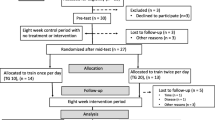Abstract
Purpose
To investigate whether a work-site strength-training program has a positive effect on self-reported psychosocial workplace factors and job satisfaction.
Methods
We conducted a randomized controlled trial among laboratory technicians implementing neck and shoulder exercises for pain relief, with 199 participants in the training group and 228 in the control group. Influence at work, sense of community, time pressure, and job satisfaction were measured with the Copenhagen Psychosocial Questionnaire at baseline and post-intervention after 20 weeks.
Results
There was no statistically significant change in any of the four variables in the training group from baseline to follow-up (all p ≥ 0.39). When we used MANOVA to test for between-group effects over time, we did not find any statistically significant result (all p > 0.14).
Conclusions
This study does not provide evidence for an effect of a work-site strength-training program on self-reported psychosocial workplace factors and job satisfaction.
Similar content being viewed by others
References
Abele AE, Silvia P, Zöller-Utz I (2005) Flexible effects of positive mood on self-focused attention. Cogn Emot 19:623–631
Biddle S, Mutrie N (2008) Psychology of Physical Activity. Determinants, well-being and interventions. Routledge, London
Brown A, Kitchell M, O’Neill T, Lockliear J, Vosler A, Kubek D, Dale L (2001) Identifying meaning and perceived level of satisfaction within the context of work. Work 16:219–226
Conn VS, Hafdahl AR, Cooper PS, Brown LM, Lusk SL (2009) Meta-Analysis of Workplace Physical Activity Interventions. Am J Prev Med 37:330–339
Dishman RK, Oldenburg B, O’Neal H, Shephard RJ (1998) Worksite physical activity interventions. Am J Prev Med 15:344–361
Engbers LH, van Poppel MN, Paw MJ, van Mechtelen W (2005) Work site health promotion programs with environmental changes: a systematic review. Am J Prev Med 29:61–70
Fox KR (1999) The influence of physical activity on mental well-being. Public Health Nutr 2:411–418
Griffin-Blake CS, DeJoy DM (2006) Evaluation of social-cognitive versus stage-matched, self-help physical activity interventions at the work place. Am J Health Prom 20:200–209
Hauke A, Flintrop J, Brun E, Rugulies R (2011) The impact of work-related psychosocial stressors on the onset of musculoskeletal disorders in specific body regions: a review and meta-analysis of longitudinal studies. Work Stress 25(3):243–256
Marshall AL (2004) Challenges and opportunities for promoting physical activity in the workplace. J Sci Med Sport 7:60–66
Pedersen MM, Zebis, MK, Langberg H, Poulsen OM, Mortensen OS, Jensen JN, Sjøgaard G, Bredahl T, Andersen LL (2012) Influence of self-efficacy on compliance to workplace exercise. Int J Behav Med [Epub ahead of print]
Pejtersen JH, Kristensen TS, Borg V, Bjorner JB (2010) The second version of the Copenhagen Psychosocial Questionnaire. Scan J Pub Health 38(Suppl 3):8–24
Rugulies R (2012) Studying the effect of the psychosocial work environment on risk of ill-health: towards a more comprehensive assessment of working conditions. Scand J Work Environ Health 38(3):187–192
Theorell T, Osika W, Leineweber C, Magnusson Hansson L, Bojner Horwitz E, Westerlund H (2012). Is cultural activity at work related to mental health in employees? Int Arch Occup Environ Health (published online 29 March)
Zebis M, Andersen LL, Pedersen MT, Mortensen P, Andersen CH, Pedersen MP, Boysen M, Roessler KK, Hannerz H, Mortensen OS, Sjøgaard G (2011) Implementation of neck/shoulder exercises for pain relief among industrial workers: a randomized controlled trial. BMC Musculoskelet Disord 12:205
Acknowledgments
This study was supported by grants from the Danish Working Environment Research Fund [Grant number: 08-2007-03]. In addition, the workplaces contributed to the study by allowing employees to train for 1 h per week for 20 weeks during paid working time.
Conflict of interest
The authors declare that they have no conflict of interests.
Author information
Authors and Affiliations
Corresponding author
Additional information
Current Controlled Trials number: NCT01071980.
Rights and permissions
About this article
Cite this article
Roessler, K.K., Rugulies, R., Bilberg, R. et al. Does work-site physical activity improve self-reported psychosocial workplace factors and job satisfaction? A randomized controlled intervention study. Int Arch Occup Environ Health 86, 861–864 (2013). https://doi.org/10.1007/s00420-012-0823-z
Received:
Accepted:
Published:
Issue Date:
DOI: https://doi.org/10.1007/s00420-012-0823-z




